As we recalled from the previous article, Cataract is a condition that clouds the eye's natural lens, and is also the number 1 cause of blindness.

When cataract develops, our lens become less transparent, and our vision tends to become blurry of hazy.
What causes Cataract?
Cataract is normally a result of aging, when the normal protein in the lens start to break down. Factors such as genetics, long-term exposure to sunglight, eye-injuries or certain medical conditions such as diabetes can also increase the risk of developing cataract.
Symptoms of Cataract
- Blurry or cloudy vision
- Glare
- Seeing halos around light
- Reduced vision
- Reduced colour sensitivity
- Reduced contrast sensitivity

(Seeing Glare)

(reduced colour sensitivity)
Diagnosis
Cataract can be detected through a comprehensive eye-examination that includes a silt-lamp examination, refraction and visual acuity test.
For patients who are diagnosed with cataract, your vision problem might not happen immediately. Hence, it is important to:
- Have an eye-examination every 2 years if you are younger than 65 years old. If you are older, we will recommend an eye-examination every year.
- Protect your eyes from UV light, Shield your eyes with a UV400 sun lens, and /or wear a wide-brimmed hat
- Limit driving at night once your night vision is affected
- Take care of any other health problem, especially diabetes
- Get the correct eyewear with the correct prescription to correct your vision.
Treatment
Cataract can only be removed with surgery. Cataract is a very common cause of blindness, however, it can be treated if detected early.
If you are experiencing any symptooms, please visit your nearest optical outlet that provides comprehensive eye-examination, or visit your nearest GP for a thorough checl.
